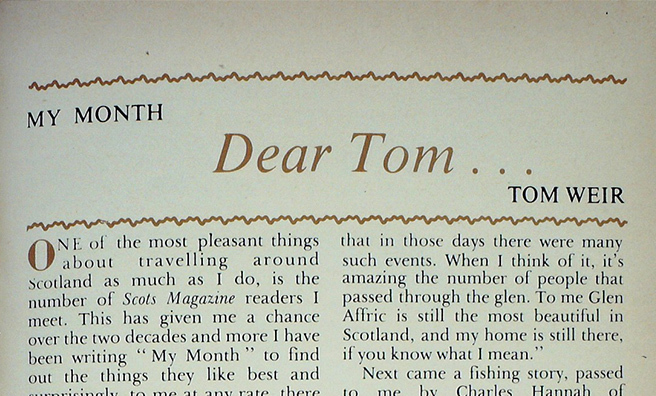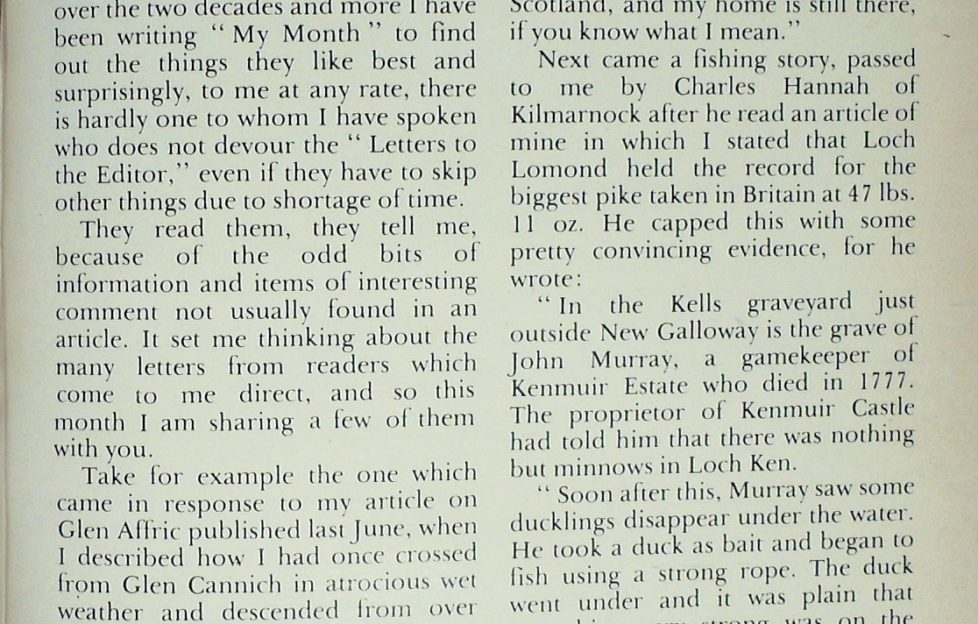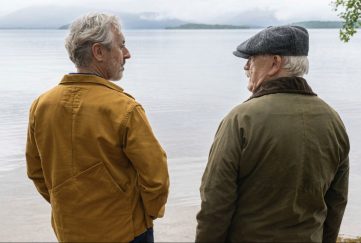Tom Weir | Dear Tom…

ONE of the most pleasant things about travelling around Scotland as much as I do, is the number of Scots Magazine readers I meet.
This has given me a chance over the two decades and more I have been writing “My Month” to find out the things they like best and surprisingly, to me at any rate, there is hardly one to whom I have spoken who does not devour the “Letters to the Editor,” even if they have to skip other things due to shortage of time.
They read them, they tell me, because of the odd bits of information and items of interesting comment not usually found in an article.
It set me thinking about the many letters from readers which come to me direct, and so this month I am sharing a few of them with you.
Take for example a fishing story, passed to me by Charles Hannah of Kilmarnock after he read an article of mine in which I stared that Loch Lomond held the record for the biggest pike taken in Britain at 47 lbs. 11 oz. He capped this with some pretty convincing evidence, for he wrote:
“In the Kells graveyard just outside New Galloway is the grave of John Murray, a gamekeeper of Kenmuir Estate who died in 1777. The proprietor of Kenmuir Castle had told him that there was nothing but minnows in Loch Ken.
“Soon after this, Murray saw some ducklings disappear under the water. He took a duck as bait and began to fish using a strong rope. The duck went under and it was plain that something very strong was on the other end. He backed to the edge of the loch, meanwhile hauling in his line, when suddenly a monster pike surfaced. He managed to land the pike and kill it.
“He carried it on his back to the castle . . . threw the fish down in front of his employer and said, Caa that a mennin?’.
“The fish weighed 72 lbs. and the head was preserved at Kenmuir Castle which is now a ruin.”
An Unusual Find…
I liked the following wee note from a Surrey reader, Mrs Joan Rainey, who had written to me for advice before going on her Highland holiday. It gave me something to chew on:
“Must tell you. Half way up the Devil’s Staircase we came upon a full and perfect set of upper dentures! Just lying in the sun grinning at us. No one about. We marked the spot—but they had gone by the time we made our return journey.”
Maybe the Devil on the staircase had looked after his own!
Following my two articles on Shetland in the April and May issues last year there came a very interesting letter from a resident at Glencairn Tower Nursing Home.
The writer told me that when he was a market gardener he used to send a consignment of vegetables to Lerwick by weekly steamer from Leith.
Mr Robert L. Scarlett went on to describe what things were like then:
“In 1930 there was a very poor trade, no price for anything and Shetland suffered severely. With the help of a Lerwick friend we advertised our cabbage plants free to those who wished them. It worked well, and many small orders were sent. At that time Shetlanders planted the cabbages in small plots surrounded by dry-stane dykes to avoid damage. Later on we learned how delighted the growers were.”
But it was the next bit of Mr Scarlett’s letter which interested me most, when he opened up the subject of the Norse conquerors of the Shetlands, and their great voyages to distant seas, as told in the Icelandic Sagas. After explaining that the language of the Sagas was, in structure, very much as it is today in modern Iceland, he wrote:
“In these Sagas it was found that the ancient Vikings from Norway and Denmark always took a quantity of onions on their longships as a means of counteracting scurvy, an affliction of seamen on long voyages. I think the Israelites used leeks on their arid desert journeys.
Perhaps the word in the ancient text was translated as leeks, when it might have been onions—both vegetables were grown in ancient times.
“I happen to be a relic of a market-gardening family who were in and around Musselburgh. I look part in the establishment of the Scottish Plain Breeding Society, The Horticultural Research Station at Invergowrie and latterly was Vice President of the East of Scotland College of Agriculture.”
I look forward to meeting Mr Robert L. Scarlett one day.
We still receive some fascinating letters from our readers either in reply to one of our articles or with suggestions for hikes to feature – or sometimes simply telling us of their experiences out and about in Scotland.
We publish a few in the letters page each month, and the best letter earns a prize. Last month we sent Fraser MacDonald from Auckland a quaich in thanks for sharing a tale inspired by Nick Drainey’s column. Read about it in our May issue.
Share your news and views with us either by email mail@scotsmagazine.com, or through the post to The Scots Magazine, D C Thomson & Co Ltd., 80 Kingsway East, Dundee, DD4 6RD.
Read more from Tom Weir next Friday
More…
Read more from Tom!
We have an extensive archive of Tom Weir’s great columns for The Scots Magazine, and we’re slowly but surely getting them published digitally for new generations to enjoy.
To see the columns we have online so far, click here.







